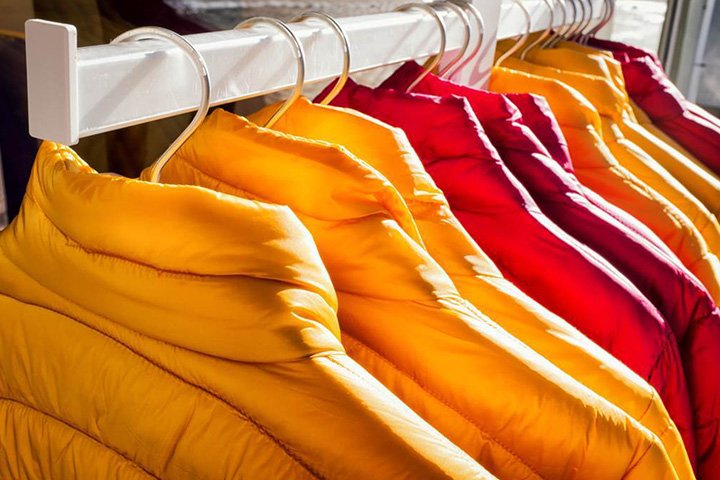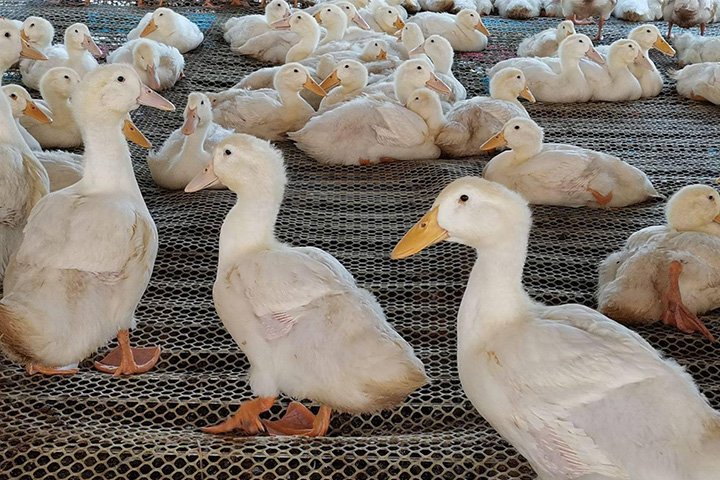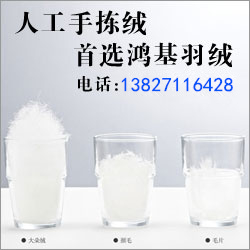Cn-down > Domestic news > News content
2024-10-14 来源:金绒 浏览量:654
Market Summary
The market conditions in the 39th week of 2024 (9.23-9.29) were generally stable.

At present, the north has begun to enter winter, and it will enter the peak season for the sale of down products, and the activity of the industry will also increase accordingly. In particular, the preparation for Double 11 is favorable for the down raw material industry. In addition, there will be cold air moving south in mid-October, and compared with previous years, this year's cold air will break out earlier and with higher intensity, and it may continue to be active for a period of time.
Good News This Week
After the National Day holiday, the weather will gradually turn cooler, so many consumers also choose to buy seasonal clothes during the Golden Week. At 6:30 in the morning, the entire market was ready to welcome consumers from all over the country. By 10 o'clock in the morning, a large number of consumers had arrived here.
Many merchants said that this autumn and winter clothing styles have begun to return to the classic and simple style. Compared with the pursuit of colorful appearance and rich functions in previous years, this year's clothing brands strive to design neat and light styles, and short puff-type down jackets have become popular styles.
After the morning meeting, Yang Wei, the manager of a clothing store in Sijiqing Clothing Specialty Street, began to sort out the hot items that may appear in the near future and adjust the marketing and inventory strategies in time. In previous years, several popular items were sold out in one day, and temporary replenishment might miss orders.

At 5 p.m., when Yang Wei was checking the inventory of goods in the warehouse, she found that the stock of an autumn coat and a down jacket was about to run out, so she quickly contacted a factory to add a production order. The day's work was finally over at 9:20 p.m.
During the holiday, Shanshan Outlets in Xiqing District, Tianjin, celebrated its first anniversary. Many brands launched new products and increased promotional discounts. Most sports brands and down clothing stores had long queues at the door.
The relevant person in charge introduced that the inventory has been increased from 15,000 to 45,000. Best-selling items will be replenished during the week. As the weather gets cooler, customers tend to choose classic extreme cold products. In addition, compared with the same period last year, sales have increased by about 12%.
source | 央视网、天津海河传媒中心
Quang Viet, a major down jacket OEM, had a consolidated revenue of NT$2.018 billion in September, down 9.63% from the same period last year. Quang Viet Chairman Wu Chaobi said that due to the adjustment of some orders to customers' shipping schedules in September, the revenue showed a year-on-year decrease, but it is estimated that the positive growth trend will be maintained in the future, and the fourth quarter will not be a slow season.
Wu Chaobi pointed out that Guangyue's operations have turned around since the second half of this year and have recovered from the bottom, with shipments booming in the third quarter peak season. The global economic downturn in the past two years and weak end-consumer demand have led to a reorganization of the supply chain in the clothing industry, eliminating the weak and retaining the strong. Manufacturers with competitive advantages can quickly pick up orders when the economy turns around and recovers.
Looking ahead to 2025, Guangyue brand customer order demand is strong and the operational outlook is promising; in addition to grasping existing customer orders and product projects, Guangyue continues to develop new customers and items; in addition, Guangyue continues to evaluate the expansion of production bases, the operating territory continues to expand, and the future outlook is positive.

Another down jacket OEM, KWONG LUNG, had a consolidated revenue of NT$666 million in September, a monthly and annual decrease. Its consolidated revenue in the third quarter reached NT$2.22 billion, a year-on-year increase of 1.6%, achieving positive growth for two consecutive quarters. In addition, KWONG LUNG's consolidated revenue in the first nine months of this year totaled NT$6.247 billion, a gap narrowed to only 2.4% compared to last year.
In the third quarter, Kwong Lung's garment division shook off the sluggish performance of the first two quarters, with shipment momentum recovering strongly, and quarterly revenue reaching NT$1.44 billion, a significant increase of more than 20% over the same period last year, a very impressive performance. At the same time, the division also filled the revenue gap of the down raw material division, which strategically reduced orders due to rising raw material prices, and its revenue share increased from 55% to 65%.
Looking ahead to the fourth quarter, Kwong Lung's main growth momentum will come from the two major divisions of apparel and home textiles. Driven by additional orders and new customers, the recovery trend of the apparel division is expected to continue until the end of the year, and revenue is expected to be second only to the peaks in 2021 and 2022. The home textile division is expected to achieve double-digit growth as it enters the traditional peak season for shipments, and the main customers continue to increase their demand for goods.
source | 中时新闻网
After the National Day holiday, on the one hand, the ducklings that were restocked earlier will be sold out one after another, and the demand for new ducklings by farmers may temporarily decline; on the other hand, some farmers may be cautious about restocking due to uncertainty about the future price of meat ducks, resulting in a decrease in demand for ducklings, and prices may fall to a certain extent in the short term.
In the long run, the price trend of ducklings will also be affected by factors such as the number of breeding ducks in stock and the hatching rate. If the number of breeding ducks in stock remains stable and the hatching rate is normal, the supply of ducklings will also be relatively stable, and the price may fluctuate within a certain range; if there are breeding duck diseases, extreme weather and other situations that affect the production or hatching of breeding ducks, the price of ducklings may fluctuate greatly.

After the National Day holiday, the centralized procurement demand for meat ducks in the catering industry and other industries will decrease, and the demand in the terminal consumer market will gradually return to the daily level, which will put some pressure on the price of meat ducks. At the same time, in order to sell them at a good price during the holiday, farmers may delay the release of some meat ducks, and these remaining meat ducks will be put on the market in batches after the holiday, which may also cause the price of meat ducks to fall due to the increase in supply.
However, in the medium and long term, the price of meat duck is expected to stabilize or rebound. As the weather gradually turns cooler, people's demand for meat will gradually increase, and the consumption of meat duck, as a common meat food, may also increase. Especially in winter, some areas have the habit of eating roast duck, stewed duck and other dishes, which will drive the consumption of meat duck and have a positive impact on the price of meat duck.
source | 网易手机网、鸡病专业网、金投网
Recently, some cost-effective "Chinese outdoor products" are very popular in Japan. So, how is the outdoor craze in China, the country of production? To this end, a Japanese reporter visited Dalian, a city in northeast China, to find out.
The winter in Dalian is very cold, with temperatures dropping below zero, but people wearing down jackets are often seen on the streets. The reporter went to one of the busiest neighborhoods in the area, but according to his observation, there was only one outdoor goods store, "Camel", in the neighborhood. Compared with Japan, there are far fewer outdoor goods stores in China, and locals said that this is because the purchase and sale of outdoor goods is mainly through online shopping.

He walked into the flagship store of the Chinese outdoor brand Camel, and saw that there were few outdoor tents and camping lights, but a relatively complete range of clothing such as shoes and jackets. In China, lightweight, durable and functional outdoor brands are highly valued.
China is known as the "world's factory", so outdoor brands from all over the world continue to ask China for OEM. Although there are few physical outdoor stores in China, there are surprisingly many outdoor brands. In addition to Camel, there are also Fire Maple, Mogo, etc. Recently, more and more Chinese outdoor products have begun to be sold in Japan, such as on Amazon.
source | 环球网
Bad News This Week
After convincing major brands and designers to stop using fur and leather, animal rights activists are now turning their attention to convincing more brands to ditch down and feathers. Recently, H&M, a global retailer headquartered in Stockholm, has vowed to no longer source virgin down for its brands.
An H&M spokesperson said: “We can confirm that our goal is to use only down and feathers from post-consumer recycling by the end of 2025. This is in line with our long-standing desire to move towards recycled and sustainably sourced materials in all our use.
H&M also stressed that currently about 90% of the down and feathers in its products are recycled from old items.

H&M's decision came after urging from People for the Ethical Treatment of Animals (PETA), calls from Oscar-winning actor Joaquin Phoenix, demonstrations outside H&M stores, and other things.
In 2021, PETA and H&M partnered to launch the "Co-exist Story" collection, a PETA-approved vegan collection in which H&M uses wildflowers instead of down to make clothing.
H&M, like many other clothing companies and home decor brands, uses down feathers to make down jackets, pillows and other items. Down jackets have been popular for a long time and the category has become a must-have item in the autumn and winter wardrobe.
source | Women's Wear Daily 女装日报
On October 1, data released by the Institute for Supply Management (ISM) showed that the U.S. ISM manufacturing index shrank for six consecutive months in September, the 22nd time in the past 23 months, reflecting weak orders and declining employment, highlighting the continuation of the manufacturing industry's downturn.
In September, the US ISM Manufacturing PMI index was 47.2, lower than the expected 47.5, and the same as the previous value in August (50 is the dividing line between prosperity and recession). In March, the index unexpectedly reached 50.3, ending 16 consecutive months of manufacturing contraction, but from the following months, the expansion achieved in a single month was only short-lived.
In terms of important sub-indices, the new order index was 46.1, which was an improvement from the previous value of 44.6 in August, but still in deep contraction; the new export order index fell 3.3 points to 45.3, the lowest since January this year, highlighting the fragility of the export market; although the production index rose by 5 points, from 44.8 in August to 49.8, it was still in the contraction range.

In addition, the employment index was 43.9, compared with 46 in the previous month. This was the fourth consecutive month of contraction, and economists expected factory employment to fall again; while the inventory index fell 6.4 points to 43.9, indicating that producers are maintaining low inventories.
In the September report, only five of the 18 industries showed an increase in activity, namely: "Petroleum and coal products", "Food, beverages and tobacco products", "Textile mills", "Furniture and related products" and "Other miscellaneous manufacturing"; 13 industries reported a contraction in activity, including "Clothing, leather and products".
The Apparel, Leather and Related Products (including Down Products) Industry Report: New Orders, Production, Supplier Deliveries, Inventory, Customer Inventory, Raw Material Prices, Backlogs, New Export Orders, and Imports all remained unchanged, but employment declined. This indicates that the industry may be facing uncertainty in market demand.
来源 | ISM
News Situation
During the National Day holiday, consumers are enthusiastic about buying seasonal clothing, and short puff-type down jackets have become popular styles. For the down clothing industry, this means that it is necessary to keep up with fashion trends and launch products that meet consumer aesthetics in order to gain an advantage in the fiercely competitive market.
The shipment volume of overseas down jacket OEM factories increased significantly in the third quarter, indicating that the international market demand for down jackets is gradually recovering and the overall trend is obviously positive. This also provides confidence for other companies in the industry, indicating that the down industry may usher in a new growth cycle. However, the fourth quarter is relatively a low season for the down jacket OEM industry.
The US manufacturing index in September has shrunk for six consecutive months, and the employment situation is not optimistic. Since the US is one of the important export markets for Chinese down products, its economic downturn may affect the demand of consumers in the country for Chinese down products. In addition, the shrinking manufacturing industry may also lead to a reduction in the production of down products in the United States.
 热门排行
中国三大羽绒生产基地之—广东吴川
全球最奢侈羽绒服排行
一件羽绒服需要多少只鸭子的羽绒?
飞丝是什么?能代替羽绒?别被骗了,三种方法让你告别假羽绒服!
2017羽绒原料价格一路上涨,究竟为何?
你的羽绒服为什么钻绒?涨知识了
羽绒被的价格一般是多少 通过成本看羽绒被价格
中国羽绒服四大品牌调查:到底谁才是最强王者?
羽绒金网:羽毛、羽绒、毛绒计价
《羽绒羽毛》、《羽绒羽毛检验方法》新版标准发布,2017年7月1日实施
热门排行
中国三大羽绒生产基地之—广东吴川
全球最奢侈羽绒服排行
一件羽绒服需要多少只鸭子的羽绒?
飞丝是什么?能代替羽绒?别被骗了,三种方法让你告别假羽绒服!
2017羽绒原料价格一路上涨,究竟为何?
你的羽绒服为什么钻绒?涨知识了
羽绒被的价格一般是多少 通过成本看羽绒被价格
中国羽绒服四大品牌调查:到底谁才是最强王者?
羽绒金网:羽毛、羽绒、毛绒计价
《羽绒羽毛》、《羽绒羽毛检验方法》新版标准发布,2017年7月1日实施
 推荐阅读
“吴川力量”助中国羽绒接轨世界
中国三大羽绒生产基地之—广东吴川
中羽协第二期新国标培训班 在“羽绒之乡”广东吴川成功举办
羽绒之乡:贵港桥圩镇将打造旅游休闲特色小镇
广西贵港桥圩镇:打造中国羽绒休闲旅游特色小镇
羽绒金网:羽毛、羽绒、毛绒计价
羽绒别急着收 中央气象台发布寒潮蓝色预警 部分地区降温超12℃
上海消保委检测 千元鹅绒被用鸭毛绒填充
冻哭丨降温10℃!鸡年首个寒潮预警来袭,你准备好了吗?
传统羽绒产业如何实现转型升级?四川玉泉镇产业集群发展
推荐阅读
“吴川力量”助中国羽绒接轨世界
中国三大羽绒生产基地之—广东吴川
中羽协第二期新国标培训班 在“羽绒之乡”广东吴川成功举办
羽绒之乡:贵港桥圩镇将打造旅游休闲特色小镇
广西贵港桥圩镇:打造中国羽绒休闲旅游特色小镇
羽绒金网:羽毛、羽绒、毛绒计价
羽绒别急着收 中央气象台发布寒潮蓝色预警 部分地区降温超12℃
上海消保委检测 千元鹅绒被用鸭毛绒填充
冻哭丨降温10℃!鸡年首个寒潮预警来袭,你准备好了吗?
传统羽绒产业如何实现转型升级?四川玉泉镇产业集群发展